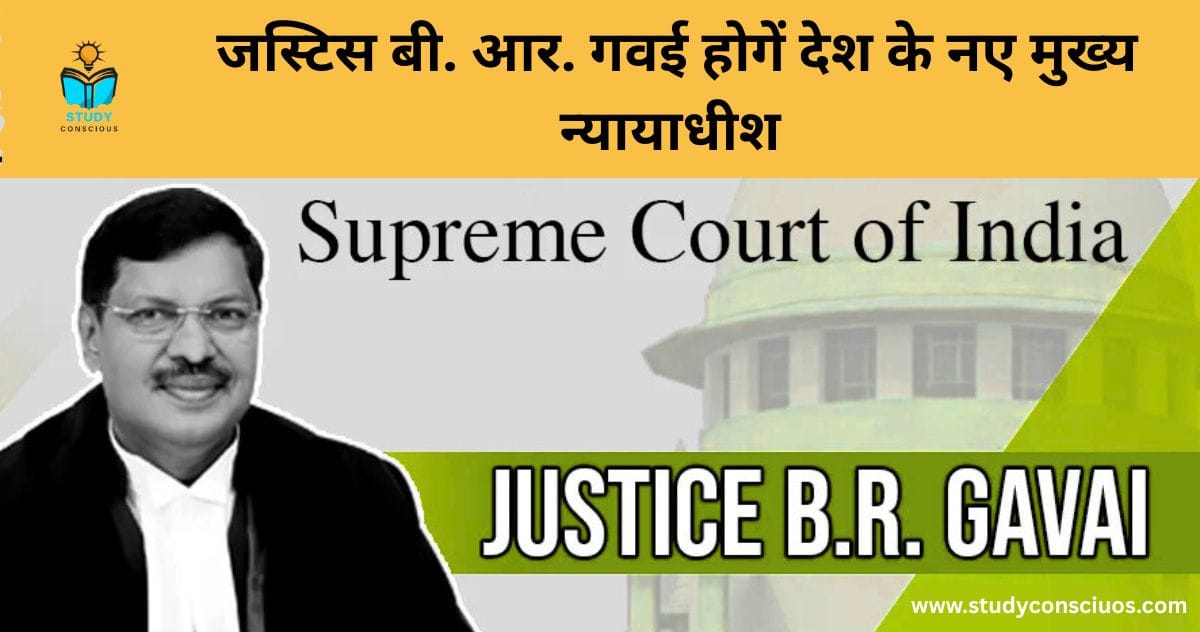Justice B.R. Gavai is a judge of the Supreme Court of India. He was appointed to the Supreme Court on 24 May 2019. He hails from Maharashtra and is known for being one of the few judges from the Scheduled Caste (SC) community to serve in the Supreme Court, which is significant for representation in the judiciary.
न्यायमूर्ति बी.आर. गवई भारत के सर्वोच्च न्यायालय के न्यायाधीश हैं। उन्हें 24 मई 2019 को सर्वोच्च न्यायालय में नियुक्त किया गया था। वे महाराष्ट्र से हैं और उन्हें सर्वोच्च न्यायालय में सेवा देने वाले अनुसूचित जाति (एससी) समुदाय के कुछ न्यायाधीशों में से एक के रूप में जाना जाता है, जो न्यायपालिका में प्रतिनिधित्व के लिए महत्वपूर्ण है।

Quick Facts about Justice B.R. Gavai: (न्यायमूर्ति बी.आर. गवई के बारे में त्वरित तथ्य:)
- Full Name: Bhushan Ramkrishna Gavai
पूरा नाम: भूषण रामकृष्ण गवई - Date of Birth: 24 November 1960
जन्म तिथि: 24 नवंबर 1960 - Education: Studied law at Government Law College, Mumbai
शिक्षा: गवर्नमेंट लॉ कॉलेज, मुंबई से कानून की पढ़ाई की - Career Highlights: (कैरियर की मुख्य बातें:)
- Started his legal practice in the Bombay High Court.
उन्होंने बॉम्बे उच्च न्यायालय से अपनी कानूनी प्रैक्टिस शुरू की। - Appointed as a judge of the Bombay High Court in 2003.
2003 में बॉम्बे उच्च न्यायालय के न्यायाधीश नियुक्त किये गये। - Elevated to the Supreme Court of India in 2019.
2019 में भारत के सर्वोच्च न्यायालय में पदोन्नत हुए।
- Started his legal practice in the Bombay High Court.
- Notable Aspects: (उल्लेखनीय पहलू:)
- Considered to be in line for becoming the Chief Justice of India (CJI) for a short tenure in 2025, based on seniority norms.
वरिष्ठता मानदंडों के आधार पर, उन्हें 2025 में अल्प कार्यकाल के लिए भारत का मुख्य न्यायाधीश (सीजेआई) बनने की कतार में माना जा रहा है।
- Considered to be in line for becoming the Chief Justice of India (CJI) for a short tenure in 2025, based on seniority norms.
🇮🇳 Supreme Court of India – Overview
Established: January 28, 1950
Location: New Delhi
Constitutional Basis: Article 124 to 147 of the Constitution of India
Building: Located on Tilak Marg, it has iconic architecture and houses several courtrooms, including Court No. 1 (used by the Chief Justice).
🔹 Role and Powers
The Supreme Court is the highest judicial authority in India and serves as:
- Guardian of the Constitution – Ensures laws and government actions comply with the Constitution.
- Final Court of Appeal – Highest authority to hear appeals from High Courts and other tribunals.
- Protector of Fundamental Rights – Citizens can directly approach the SC under Article 32 for enforcement of fundamental rights.
- Judicial Review – It can strike down unconstitutional laws or executive actions.
🔹 Composition
- Chief Justice of India (CJI) – Head of the judiciary system.
- Total Strength: Maximum of 34 judges (including the CJI).
- Judges are appointed by the President of India based on recommendations by the Collegium System.
🔹 Jurisdiction Types
- Original Jurisdiction – Disputes between the Union and states or between two or more states.
- Appellate Jurisdiction – Appeals against judgments from High Courts.
- Advisory Jurisdiction – President can seek SC’s advice on legal or constitutional matters (Article 143).
🔹 Landmark Judgments
- Kesavananda Bharati v. State of Kerala (1973) – Basic Structure Doctrine.
- Maneka Gandhi v. Union of India (1978) – Expanded the scope of personal liberty.
- Navtej Singh Johar v. Union of India (2018) – Decriminalized homosexuality.
- Ayodhya Verdict (2019) – Resolved the long-standing Ram Janmabhoomi-Babri Masjid dispute.
🔹 Interesting Facts
It is one of the few supreme courts in the world that citizens can directly approach for enforcement of constitutional rights.
Proceedings are mostly conducted in English.
The SC has a powerful tool called Public Interest Litigation (PIL).
Our Recent Bolgs:
ट्रंप ने भारत सहित 180 देशों पर रेसिप्रोकल टैरिफ लागू किया || Trump Imposed Reciprocal Tariffs on 180 Countries Including India
बंगाल विभाजन 1905: इतिहास, कारण, भूमिका || Bengal Partition 1905: History, Causes, Role
राजभाषा क्या है – परिभाषा, अनुच्छेद और कार्य || What is Official Language – Definition, Articles and Functions











